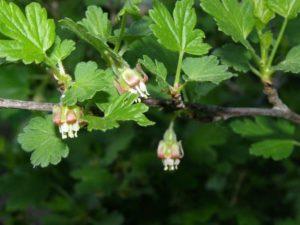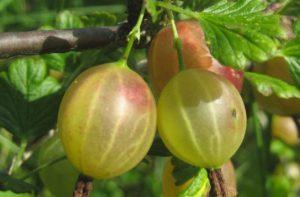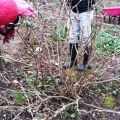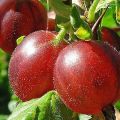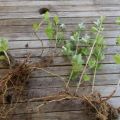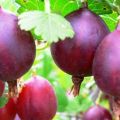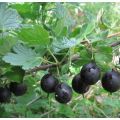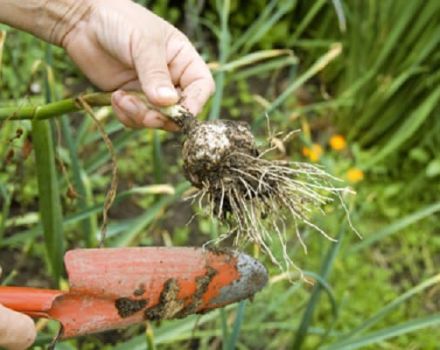Description of varieties of Finnish gooseberry varieties, cultivation and reproduction
Gooseberry is a common garden shrub with sweet and sour berries. For a long time, the problem was the susceptibility of gooseberries to powdery mildew and poor resistance to low temperatures in winter. Finnish breeders have developed varieties that can withstand both frost and the phyto-epidemic of powdery mildew. Common varieties of Finnish gooseberries:
- Finnish red - Hinnonmaki Rot;
- Finnish yellow - Hinnonmaki Gelb;
- Finnish green - Hinnonmaki Green.
Description of gooseberry Finnish
The choice of gooseberries is influenced by the personal preferences of the gardener, varietal characteristics of bushes and berries, and ripening times. Often the determining factor is the taste and color of the berries, as well as the size and prickleness of the bush.
Finnish Red Rot
Hinnonmaki Rot is one of the most delicious varieties, popularly called "northern grapes". Berries can be used fresh and to obtain juices, wine material, jam. Productivity - up to 12 kg per bush.
Bush
Red-fruited gooseberry bushes grow up to 1.2 m in height. They have peeling bark of dark gray or dark brown color. The bush is compact, but branched with a large number of needle spines.

Leaves and peduncles
Short-pubescent leaves of dull green color have 3-5 lobes with obtuse-toothed edges. The flowers are bisexual, bloom in May. Flowers are located 2-3 in the axils of the leaves. The color is reddish or greenish.
Fruit
The berries of the Finnish red gooseberry have a smooth, thin reddish-purple skin with light veins. They are spherical in shape of medium size, slightly pubescent. The taste is sweet and sour, aromatic. Berries weight 5-10 g. Ripen at the end of July.
Finnish Yellow Gelb
Due to its frost resistance, Hinnonmaki Gelb is suitable for growing in the northern regions of Russia. Some gardeners consider its berries to be the standard of gooseberry taste.

Bush
The Finnish yellow gooseberry has a dense bush with thorny branches. There are few of them, but they are prickly. The shrub is compact, about 1 m high and wide. The bush is fast-growing. It grows 20-40 cm per year.
Leaves and peduncles
Leaves are light green with 3-5 lobes. Flowers are bisexual, greenish, bloom in May.
Fruit
The berries are yellow, the skin is smooth and thin. The shape is oval-round. The size is medium, from 5 g. They have an apricot-like taste.
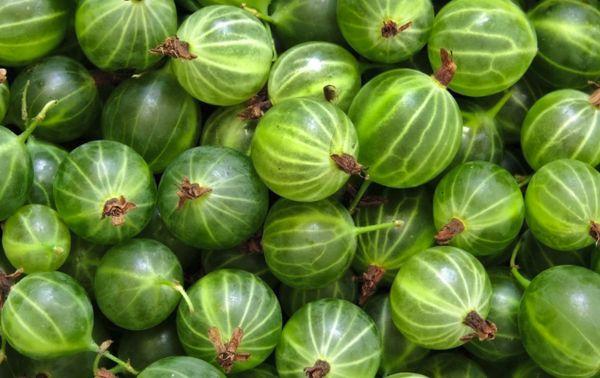
Finnish Green Green
The synonymous name is Hinnonmäki Grön. The gooseberry bears fruit abundantly every year.It is a good honey plant.
Bush
Thorny bushes with dark gray or dark brown bark. They reach 0.9-1.3 m in height. The crown is slightly spreading.
Leaves and peduncles
Leaves are dull green, short-pubescent, three- or five-lobed. Flowers are yellow-green, bloom in May.
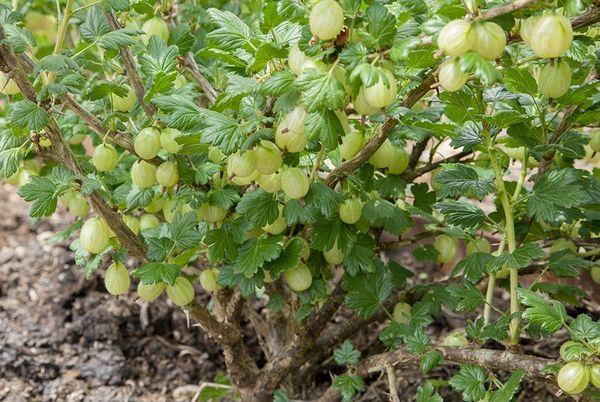
Fruit
The berries are olive-colored with veins and have an elongated oval shape. Their weight is 6-8 g. Berries are fragrant, sweet and sour taste with thin skin. Yields up to 9 kg per bush can be achieved.
Variety characteristics
Finnish gooseberry varieties are dessert, fast-growing, self-fertile. Fruiting in the third year after planting. In terms of ripening, they are classified as medium-late varieties. They are hardy and do not require special growing conditions. You can achieve productivity up to 13 kg of berries from a bush. Finnish gooseberry tasting ball - over 4.5.
Main pros and cons
In the course of breeding, Finnish varieties have achieved resistance to many diseases typical of gooseberries. They are highly resistant to powdery mildew, including spheroteca and mildew. Resistance to other fungal diseases is average.
Frost-resistant varieties. Withstand temperatures up to -30 degrees. They bear fruit stably, do not crumble with proper care, root well. The berries are sweet, versatile in use.
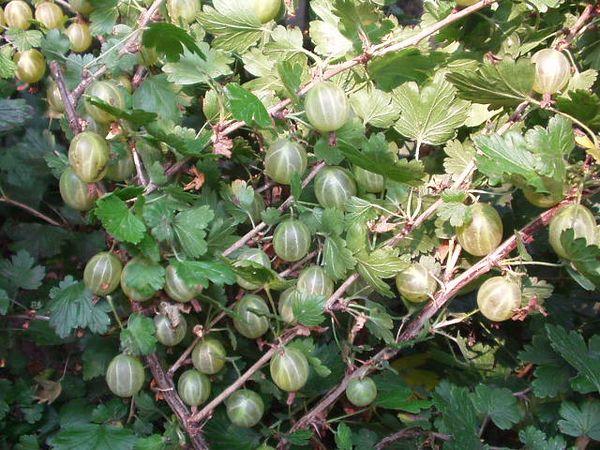
Main disadvantages:
- prickly;
- average size and weight of berries.
It is believed that the thorny varieties, which include the Finnish gooseberry, have sweeter berries than the thornless ones.
How to grow a crop
To grow a healthy plant with high yields, you should not only follow the planting rules, but also choose high-quality planting material and properly prepare the soil. The same guidelines apply to Finnish varieties as to other varieties.
Drop off time
Finnish gooseberries can be planted in both spring and fall. Autumn (until mid-October) is the preferred time for disembarkation. Before the onset of frost, the gooseberry forms young roots, which contributes to better survival.
Due to the early growing season, the spring planting time is limited to March - early April. When planted at a later date, the plants develop worse and later begin to bear fruit.
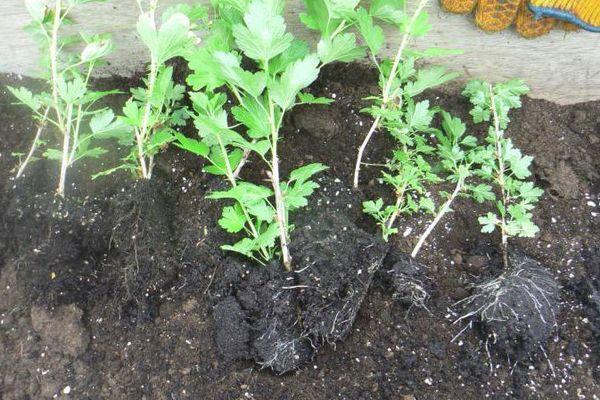
Soil preparation
Choosing a planting site and preparing the soil is one of the determining factors in the yield of Finnish gooseberry varieties. There are general rules for these varieties:
- The planting site should be flat, well-lit, moderately moist. A slope of 1-3 degrees is allowed. The occurrence of groundwater is not closer than 1 m from the surface.
- Row crops (corn, beets, potatoes), annual and perennial grasses, and black fallow are considered good predecessors.
- The variety is suitable for fertile loose loamy soils. You should start preparing the soil 1-2 years before planting. To do this, they fight weeds, apply organic fertilizers, lime acidic soils.
- In the year of planting in September, the soil is dug up with the introduction of organic fertilizers (compost or manure), superphosphate, potassium salt. You can sow green manure in the area.
Planting in shaded areas with a high groundwater table or in wetlands leads to poor gooseberry development and causes disease.
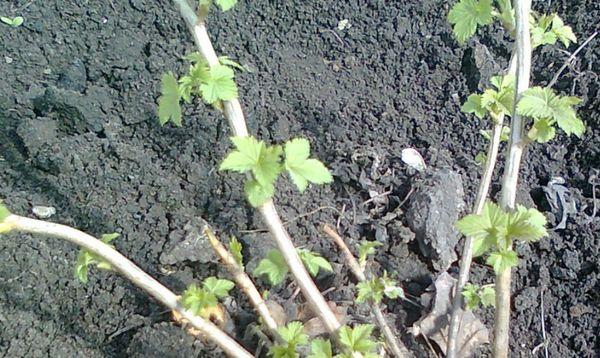
The choice of planting material
For planting, use healthy seedlings that meet the requirements:
- the ground part should consist of three strong shoots with a basal stem diameter of about 1 cm;
- the root system should be developed, the length of the roots is 20-30 cm.
The high quality of the planting material is a prerequisite for the good survival rate of the variety.
Planting process
The planting process is typical for gooseberries. Landing should be done in the following sequence:
- Prepare furrows (width 40 cm, depth 25-30 cm) or pits (width 40 cm, length 30-50 cm, depth up to 40 cm).Form rows at a distance of 3-3.5 m from each other.
- Spread out the roots of the seedling. Place the plant in the hole, sprinkle with fertile soil. Around the seedlings, compact the earth and shed well (half a bucket of water on the bush). Mulch the surface with dry soil, peat mixture or humus.
It is recommended to cut the stems up to 5 cm, keeping 3-4 buds on the shoot. This is believed to speed up the formation of the bush.
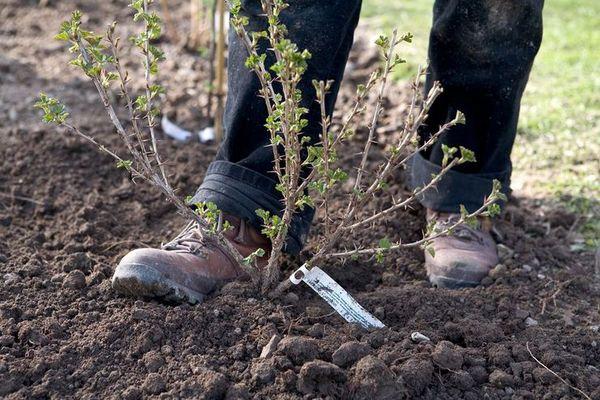
Finnish gooseberry care
Finnish gooseberries do not require any special care. Correct watering, timely feeding and shrub formation ensure good fruiting and are the prevention of diseases.
Watering rules
In order to preserve moisture as much as possible, it is recommended to cultivate the soil around the bushes every spring. You can water it with cold water from a well or well, but the fruits will ripen a few days later than with warmer water. Irrigation will require less than 30-40 liters of water per 1 sq. m. In case of dry weather, humidification is mandatory at the stages:
- the formation of berries after flowering;
- 1-2 weeks before harvest;
- after the harvest is harvested.

Best watering methods for Finnish gooseberries:
- from the irrigation ditch - water fills a small ditch formed by pouring a roller 10-15 cm from the ground at a distance of 40 cm from the plant;
- drip - water is supplied from drip irrigation systems, laid at a distance of 15-20 cm from the row.
Sprinkler irrigation and flood irrigation are uneconomical and do not provide an even distribution of moisture.
Fertilization
Top dressing should be systematic and phased. Three steps are recommended:
- At the stage of bush formation, a solution with urea and nitrophosphate is introduced.
- Top dressing with potassium sulfate or a special gooseberry nutrient mixture during flowering.
- During the period of active growth and formation of fruits, it is useful to feed them with nitrophosphate and potassium humate.
For gooseberries, it is recommended to avoid the use of fertilizers containing chlorine, good nutrition is wood ash, to which lime can be added to reduce the acidity of the soil.
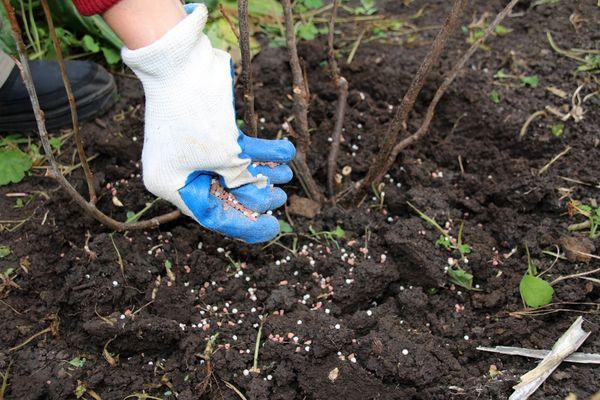
Trimming and shaping
The purpose of pruning is the correct formation of the crown of the bush and reducing its density. When pruning Finnish varieties, the following rules should be followed:
- do pruning in autumn or early spring;
- shoots 5-7 years old are valuable;
- small shoots and shoots older than eight years should be cut;
- from the age of five to six, it is recommended to remove 3-4 old branches with weak fruiting and an increase of less than 30 cm.
Sometimes gardeners cut off the green tops of the shoots in the summer to increase the size of the berries.
Protection against diseases and pests
Finnish varieties are resistant to most types of gooseberry diseases. If an infection has occurred, then to fight you can use:
- fungicides "Title", "Topaz", "Karatan";
- insecticides, for example, "Bitoxibacillin", "Fufanon", "Actellik".

It is recommended to grow gooseberries in one place for up to 10 years. For the prevention of diseases, thickening of the bushes should not be allowed. Every year it is necessary to normalize the shoots and carry out sanitary pruning. Sprinkling is not advised. Moisture on the leaves and berries can cause fungal infections.
Breeding varieties
Finnish gooseberry varieties are propagated:
- layering;
- cuttings;
- dividing the bush.
Reproduction by layering is a simple and affordable way. For reproduction, two-year-old shoots are chosen, located near the soil. Further it is necessary:
- Make a groove at the shoot, loosen the earth in it.
- Bend the shoot to the groove and secure it with staples.
- Sprinkle the shoot with earth, forming a mound.
- With pruning shears, shorten the shoot by 20%.
The soil in the area where the shoot is located should be kept slightly moist.
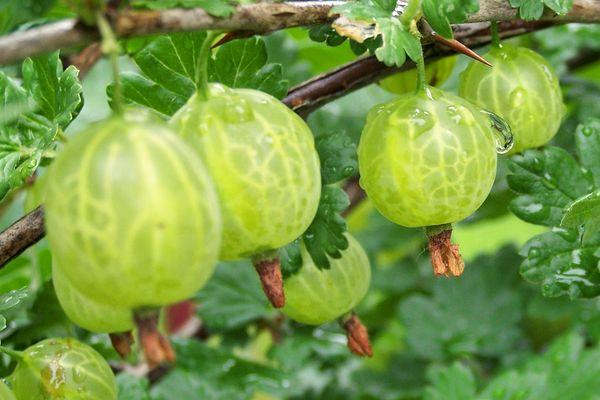
Cleaning and storage
Cleaning should be done on a clear, dry day.The berries of Finnish varieties are soft and juicy. Therefore, mechanical assembly is unacceptable for them. Due to the spikiness, harvesting berries becomes more difficult.
To soften the gooseberry thorns, water the bush abundantly from a watering can 2 hours before harvesting, including over the leaves. In order not to get pricked, you should work in long-sleeved clothing and heavy gloves.
The berries are removed from the bush together with the stalk and pricked into dry, shallow containers. Ripe berries are stored in a cool place for up to 5 days. Unripe berries can be stored for up to 10 days. You can increase the shelf life by freezing or drying gooseberries. Jams, preserves, compotes are made from gooseberries.
